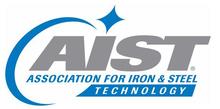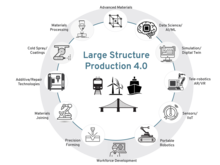MfgTech Roadmap - Revitalizing Traditional Industries
Innovations within traditional industries help ensure they remain globally competitive. The roadmaps listed below will forecast approaches to supplement labor needs and ways to manufacture faster, more cost-effectively, and with fewer materials than traditional methods. They will explore transitioning toward 3D printing, prefabrication, modular construction, digital designs, and the use of artificial intelligence to investigate new materials.
| Title | Lead Organization |
| AI-Enhanced Multimodal Sensing of Materials and Process for Complete Product of Lifecycle Performance | Case Western Reserve University |
| Iron and Steel Manufacturing: Revolutionizing U.S. Global Leadership for a Sustainable Industrial Supply Chain | Association for Iron & Steel Technology |
| Advanced Technologies for Digitalization of Construction Industry | American Society for Testing and Materials |
| Roadmap for Accelerating Production of Large Structures and Systems | Edison Welding Institute, Inc. |
AI-Enhanced Multimodal Sensing of Materials and Process for Complete Product of Lifecycle Performance
| Leading Organization: | Partners: |
| Case Western Reserve University (OH) |
|
Publication Date: January 2024
Accomplishments:
- Established a plan to develop multimodal sensing and AI/ML-driven closed-loop control capabilities and data insights to help manufacturers improve full product lifecycle performance.
- Found four goals: integrate multimodal data over multiple timescales, capture domain insights from materials science and manufacturing, develop feedback strategies over multiple timescales, and develop core technologies necessary to achieve the vision.
- Found three core focus areas across the product lifecycle: sensing, data acquisition, and data management, applications of AI/ML and data analytics, and comprehensive integration of data and AI/ML insights.
For more information, visit: https://case.edu/issacs/programs/nist-manufacturing-technology-roadmapping
Iron and Steel Manufacturing: Revolutionizing U.S. Global Leadership for a Sustainable Industrial Supply Chain

| Leading Organization: | Partners: |
Association for Iron & Steel Technology (PA) |
|
Publication Date: July 2025
Accomplishments:
- Identified three cross-cutting themes needed in revolutionizing iron and steel manufacturing: 1) smart manufacturing, 2) infrastructure, facilities, and tools, and 3) education and workforce.
- Identified four industry sectors and described the iron and steelmaking process and their carbon intensities.
- Aimed to identify an economically viable pathway to achieve a net-zero-emission iron and steel industry by 2050.
Advanced Technologies for Digitalization of Construction Industry

| Leading Organization: | Partners: |
American Society for Testing and Materials (PA) |
|
Publication Date: September 2023
Accomplishments:
- For the past decades, the construction sector has grown in profitability, but not productivity. To address this gap, eight advanced technologies with the potential to benefit the construction sector were found: additive manufacturing, robotics and automation, big data, internet of things, artificial intelligence, simulation, augmented reality, and cybersecurity.
- When the eight advanced technologies are added to traditional construction, six key application areas in digital construction will be enabled: sustainable buildings, smart infrastructure, mass housing, disaster response, operation resilience, and construction in space.
- Eight priority challenges to digitalization were identified and sorted into the following topics: standards and codes, data and integration, technological advancement, economics and business models, and education, workforce, and awareness. Each challenge has priority actions for success.
For more information, visit: https://amcoe.org/advanced-technologies-for-digitalization-of-construction-industry
Roadmap for Accelerating Production of Large Structures and Systems

| Leading Organization: | Partners: |
Edison Welding Institute, Inc. (OH) |
|
Publication Date: August 2024
Accomplishments:
- Created a consortium of the leading US materials, additive manufacturing, forming, joining, cold spray, automation, and robotics organizations.
- Conducted focus groups in Ohio, Florida, Illinois, and New York communities to identify gaps and data to key industrial sectors.
- Identified priorities that if addressed, could reduce waste, scrap, and rework, as well as increase productivity of joining and forming operations.
For more information, visit: https://ewi.org/introducing-a-u-s-roadmap-to-accelerate-production-of-large-structures-and-systems/

